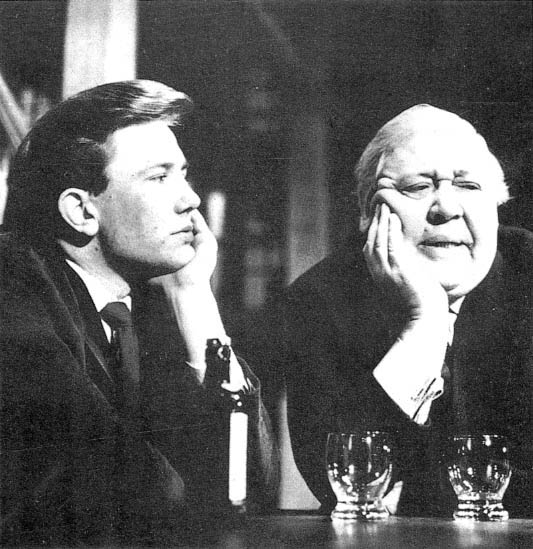Charles Laughton (56 page)
Authors: Simon Callow


Laughton briefly encounters Marilyn Monroe in
O. Henry’s Full House
, 1952.

Laughton and, right, Henry Daniell in
Witness for the Prosecution
, 1957.
 s
sMembers of the Stratford company, 1959: (l. to r.) Laughton, Leslie Caron, Peter Hall, Angela Baddeley, Paul Robeson, Mary Ure, Edith Evans, Glen Byam Shaw (on stairs), Harry Andrews, Laurence Olivier.

Laughton as Lear and Bottom, 1959.

Laughton and Albert Finney in
The Party
, 1958.

The late films.

The Paradine Case
, 1948.

The Bribe
, 1949.

Night of the Hunter
(Laughton directing Lillian Gish), 1952.
Advise and Consent
, 1962.
Acknowledgements
More than most writers, biographers are dependent on the kindness of strangers. When I started writing this book I took every opportunity to mention in interviews on television and in the newspapers that I was doing so, and the result was far beyond my expectations. People wrote to me from all over the world with reminiscences of Laughton and suggesting places where I might find further information. Ken Barrow, the distinguished biographer of Flora Robson and Robert Donat, was extraordinarily kind in this regard, directing my attention to archives whose existence I hadn’t suspected and sharing his own research with me as both Robson and Donat were friends of Laughton – this proved invaluable. Constance Cummings provided me with an absolute treasure trove of press cuttings of the production of
The Man with Red Hair
(adapted by her husband, Benn Levy). Philip Jenkinson enabled me to see a number of rare Laughton films and put me on to an aspect of Josef von Sternberg’s state of mind while directing
I Claudius
that I had hitherto not suspected. Benita Armstrong, Elsa Lanchester’s best friend in the thirties, gave me brilliant glimpses of the life of the young couple. Benita, Charles Laughton’s friend, student and fellow actor, not to mention being one of the world’s greatest ice-skating artists, offered me many remarkable insights into Laughton as teacher, director and friend. But equally forthcoming were people whom I could never have tracked down had they not come forward; ex-employees of the Pavilion Hotel in Scarborough, secretaries, understudies, stage managers; all with some revealing glimpse of the great man. Absolutely indispensable among these were the memories of Ann Rogers, his secretary in London in the late fifties and John Beary, Personal Assistant and friend. To all of these many thanks; and especially perhaps to the lady whose name I have tragically lost, who furnished me with the three letters that Charles Laughton wrote to her aunt, Hepsebiah Thompson, from the front in 1919.
Billy Wilder was the first person I interviewed for this book, and Albert Finney was the last; they must stand for the vast army of Laughtonians who generously contributed reminiscences, analyses and recollected affections. Everyone was kindly disposed, even when their experiences at Charles’ hands had not been agreeable.
In addition, I would like to thank Marion Rosenberg, my friend and agent, for putting me in touch with Roddy MacDowell, and in so doing opening many doors on Laughtons’s life; Edward Johnson, who helped me fill in some gaps in my knowledge of Laughton’s films, and in addition compiled the discography at the back of the book; Graham Jackson, whose initial spadework was the foundation for everything; and Ann Jack, who typed most of the book. The librarians of the Special Collections Department of the Research Library at the University of California, Los Angeles were wonderfully kind and efficient. My old friend, Peter Whitman, put me right on a number of matters, particularly those relating to the Oscars, on which he is a world authority. Charles Nolte who suffered under and learned from Charles Laughton when he acted for him in THE CAINE MUTINY TRIAL, kept a fascinating diary of the period which he generously allowed me a glimpse of; Bruce Zortman, Laughton’s amanuensis during his last years wrote down the actor’s sketchily remembered early autobiography and gave me sight of that most stimulating if frustrating document.
Nick Gray, director of the parallel television documentary, was with me every step of the way, funny and shrewd; while Helen McGee, who researched the programme, is without peer in her trade, a genius of the quick follow-up and the persistent phone-call; without her this book would be much less useful.
My friend Angus Mackay put his huge library and wonderfully-stocked mind at my disposal from the very beginning, and then read the manuscript with an eagle eye for fact and form; Nick Hern onlie begot the whole project and then patiently waited and watched throughout its elephantine gestation; Peggy Ramsay provided the inspiration and the encouragement in ways too numerous and too subtle to detail; and Bruno never once complained.
S.C
.
APPENDICES
CHARLES LAUGHTON
Reading in Alaska
I am a tourist at heart. I wanted to go to Japan to see the cherry blossoms, the tea ceremony and the geishas, the Japanese gardens, and Mount Fujiyama. And I went to Japan and it wasn’t cherry blossom time, and I didn’t see a geisha, except clacking along a back street of Kyoto with her attendant holding an oiled paper umbrella over her head in the rain. And the Japanese gardens are not at all as advertised – frail and dainty – but solemn religious exercises in stone and green sculptured bushes, and trees and gravel, which is much better.